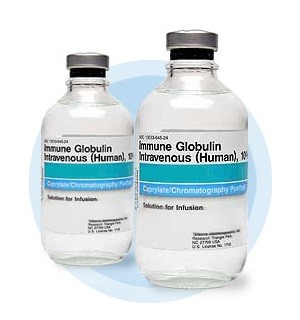
Contents
What Is Intravenous Immunoglobulin Used For?
Intravenous Immunoglobulin (IVIG) is used for various conditions.
IVIG therapy is a treatment for people with weakened immune systems. IVIG is made up of antibodies prepared from pooled plasma of over 1,000 healthy blood donors. The pooled plasma samples are purified before administration.
Humans have five primary types of immunoglobulins: IgG, IgM, IgA, IgD, and IgE. IVIG products consist mainly of IgG antibodies, along with traces of IgM and IgA. These antibodies are naturally present in blood, without immunization or antigen exposure.
When is IVIG used?
IVIG is used in two opposing ways:
- To suppress inflammatory response in people:
- With autoimmune disorders
- Who undergo solid organ transplants to prevent graft-versus-host disease (the transplant patient’s immune system attacks the transplanted organ)
- Who undergo bone marrow transplants to prevent graft-versus-host disease (the new immune cells from the transplanted bone marrow attack the transplant patient’s own body)
- For primary immunodeficiency caused by hereditary or genetic conditions
- For secondary immunodeficiency caused by diseases and infections such as HIV
How does IVIG work?
IVIG works in multiple ways. It suppresses the immune system’s inflammatory response by:
- Blocking Fc receptors, which activate upon molecular coupling with antigens, on the membranes of immune cells.
- Modulating the activation of the complement immune system, consisting of plasma proteins activated by pathogens.
- Suppressing antigen-specific antibodies.
- Suppressing proteins that cause inflammation, such as cytokines and chemokines released by immune cells.
The natural IgG antibodies in IVIG can:
- Prevent infection by binding to pathogens
- Aid in removal of dying cells and altered cells, such as tumors
- Induce growth of myelin, the sheath around nerves that enables normal transmission of nerve signals
- Inhibit growth of autoreactive B cells, which attack native tissue
What is IVIG used for?
IVIG is used to treat several autoimmune and infectious diseases, as well as conditions with no known cause. The FDA-approved uses of IVIG are:
- Common variable immunodeficiency (CVID): A group of approximately 150 primary immunodeficiencies (PIDs) with different underlying causes
- Chronic inflammatory demyelinating polyneuropathy: A nerve disorder causing weakness and loss of sensation in the legs and arms (Gamunex is the only approved drug for this condition)
- Primary immunodeficiency disorders associated with defects in humoral (antibody-mediated) immunity
- Immune-mediated thrombocytopenia: An autoimmune blood disorder in which the immune system attacks platelets
- Kawasaki disease: A condition causing inflammation of blood vessels, often affecting children under five
- Chronic B-cell lymphocytic leukemia
- Pediatric HIV type 1 infection
- Multifocal motor neuropathy: An immune-mediated disorder causing muscle weakness and atrophy
How is IVIG administered?
IVIG is prepared from pooled plasma of thousands of healthy donors. The higher the number of donors, the wider the array of antibodies. The Immunoglobulins are extracted from the plasma, further purified to isolate immunoglobulin G, and remove other plasma proteins and any pathogens present.
IVIG administration is usually performed at an infusion center, especially during initiation. Subsequent IVIG infusions may be performed at home by an experienced infusion nurse, usually given every three or four weeks.
Patients receiving IVIG undergo regular tests and monitoring, including:
- Liver function tests
- Kidney function tests
- CBC count with differential
- Hepatitis screening for possible transmission from IVIG
- Immunoglobulin levels
- Rheumatoid and cryoglobulin levels
What are the FDA-approved IVIG preparations?
Minimum standards for IVIG preparations, as published by the World Health Organization, are:
- IVIG should be extracted from a minimum of 1000 donors
- It should contain as few IgA molecules as possible
- It should be free of preservatives or stabilizers that may accumulate in the body
- The IgG molecules should be as little biochemically modified as possible
The FDA-approved human IVIG preparations are:
- Gammagard Liquid: Approved for primary humoral immunodeficiency, multifocal motor neuropathy
- Other FDA-approved uses include: primary humoral immunodeficiency, B-cell chronic lymphocytic leukemia, immune thrombocytopenic purpura, Kawasaki syndrome
- Other FDA-approved uses include: primary humoral immunodeficiency, immune thrombocytopenic purpura
- Other FDA-approved uses include: primary humoral immunodeficiency
- Other FDA-approved uses include: primary humoral immunodeficiency, immune thrombocytopenic purpura
- Other FDA-approved uses include: primary humoral immunodeficiency, immune thrombocytopenic purpura, chronic inflammatory demyelinating polyneuropathy
- Other FDA-approved uses include: primary humoral immunodeficiency
- Other FDA-approved uses include: primary humoral immunodeficiency
- Other FDA-approved uses include: primary humoral immunodeficiency for adults and adolescents
- Other FDA-approved uses include: primary humoral immunodeficiency for 2 years and older, chronic immune thrombocytopenic purpura for adults
Other IVIG products marketed in the United States include: Gammar-P IV, Iveegam, Polygam S/D, Sandoglobulin, Venoglobulin-I, Venoglobulin-S, Gamimune-N
What are the side effects and complications of IVIG therapy?
Adverse effects occur in 5% to 15% of all IVIG infusions and in 20% to 50% of patients undergoing IVIG therapy. Most side effects are mild and transient, and if they occur during an infusion, the infusion is slowed or stopped.
Common side effects include:
- Headache
- Flushing
- Chills
- Muscle pain (myalgia)
- Wheezing
- Rapid heart rate (tachycardia)
- Lower back pain
- Nausea
- Low blood pressure (hypotension)
Other risks and complications reported include:
- Severe allergic (anaphylactic) reactions from IgA in patients with IgA deficiency
- Pompholyx eczema, a type of eczema causing fluid-filled blisters in palms and feet
- Acute renal failure (uncommon, but irreversible)
- Blood clots (thrombosis), transient serum sickness, and transient neutropenia (rare)
- Thromboembolism, especially in patients with underlying conditions, leading to mini-strokes (transient ischemic attack), heart attack (myocardial infarction)
- Fever, neck stiffness, headache, confusion, nausea, vomiting
- Hyperproteinemia (excess protein in blood), increased serum viscosity, pseudohyponatremia (low sodium in blood)
By clicking Submit, I agree to the MedicineNet’s Terms & Conditions & Privacy Policy and understand that I may opt out of MedicineNet’s subscriptions at any time.


